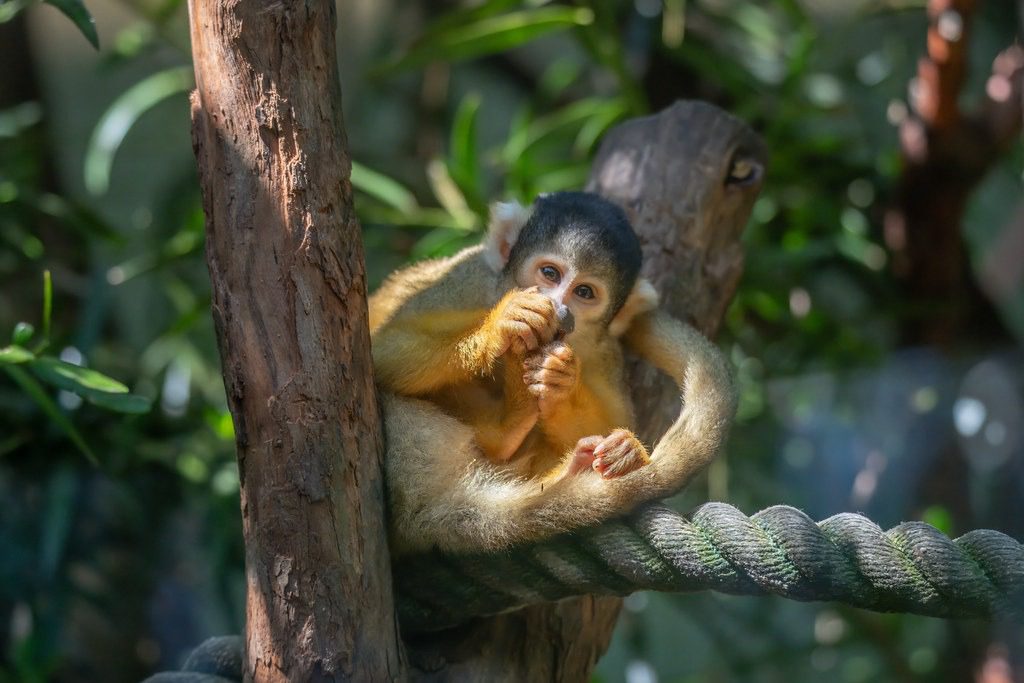Introduction
The squirrel monkey is one of the most captivating primates in the animal kingdom, known for its agility, intelligence, and expressive face. Native to the tropical forests of Central and South America, these small monkeys have intrigued scientists and animal lovers alike. In this comprehensive guide, we will explore everything there is to know about squirrel monkeys, including their lifespan, diet, habitat, and more. We’ll also delve into fascinating facts and unusual behaviors that make this primate stand out.
Taxonomy and Species Overview
Scientific Name of the Squirrel Monkey
The scientific name of the common squirrel monkey is Saimiri sciureus. The genus Saimiri includes several species such as:
- Common squirrel monkey (Saimiri sciureus)
- Black-capped squirrel monkey (Saimiri boliviensis)
- Black squirrel monkey (Saimiri vanzolinii)
Each of these species has distinct physical and behavioral traits but shares similar core characteristics.

Squirrel Monkey Size and Appearance
How Big Are Squirrel Monkeys?
Squirrel monkeys are small-bodied primates, with an average body length of 9.8 to 14 inches (25 to 35 cm), not including the tail. Their tail adds another 14 to 17 inches (35 to 42 cm), which they use primarily for balance.
- Weight: 1.7 to 2.5 pounds (0.75 to 1.1 kg)
- Fur Color: Yellowish-orange limbs and white face with black mouth and eyes
- Tail Use: Non-prehensile but essential for balance in tree canopies
Squirrel Monkey Lifespan
How Long Do Squirrel Monkeys Live?
In the wild, squirrel monkeys typically live for 15 to 20 years. In captivity, where they are safe from predators and diseases, they can live up to 25 years.
- Wild Lifespan: 15–20 years
- Captive Lifespan: Up to 25 years
- Factors Affecting Lifespan: Predation, disease, food availability, and social stability
Squirrel Monkey Diet
What Does a Squirrel Monkey Eat?
Squirrel monkeys are omnivores, meaning their diet includes both plant and animal matter. Their diet is incredibly diverse and varies with season and habitat.
- Fruits and Berries: Primary food source
- Insects: Grasshoppers, crickets, caterpillars
- Small Vertebrates: Occasionally small frogs or lizards
- Flowers, Seeds, and Nuts: Supplemental nutrition
Are Monkey Nuts Part of Their Diet?
Despite the popular term “monkey nuts” for peanuts in shells, squirrel monkeys do not typically eat peanuts in the wild. However, in captivity, they may be offered nuts as treats under controlled conditions.
Squirrel Monkey Habitat
Where Do Squirrel Monkeys Live?
Squirrel monkeys inhabit the tropical rainforests of Central and South America, particularly in countries like Brazil, Peru, Colombia, and Bolivia.
- Primary Habitat: Lowland rainforests and secondary forests
- Canopy Dwellers: Prefer the upper and middle forest layers
- Climate Preferences: Humid, warm environments with plenty of rainfall
Habitat Range by Species
- Black-capped squirrel monkey: Bolivia and surrounding areas
- Black squirrel monkey: Limited to the Mamirauá Reserve in Brazil
- Common squirrel monkey: Widespread across the Amazon Basin
Squirrel Monkey Behavior and Social Structure
Group Living and Communication
Squirrel monkeys are highly social animals, living in large troops of 20 to 500 individuals. These troops are often matriarchal and feature complex communication systems.
- Vocalizations: High-pitched calls and chirps
- Body Language: Tail positioning and facial expressions
- Social Hierarchy: Dominated by females during the breeding season

Squirrel Monkey Reproduction and Development
Baby Squirrel Monkey Facts
The birth of a baby squirrel monkey is a major event in the troop. Females usually give birth to one infant per year, typically during the rainy season.
- Gestation Period: Approximately 150 to 170 days
- Infant Weight: About 100 grams at birth
- Maternal Care: Babies cling to their mother’s back for several weeks
- Weaning Age: Around 4 to 6 months
Squirrel Monkey Predators and Threats
Natural Predators
Squirrel monkeys face many dangers in the wild from a variety of predators:
- Birds of Prey: Harpy eagles and hawks
- Snakes: Boa constrictors
- Big Cats: Jaguars and ocelots
Human-Related Threats
- Deforestation: Loss of habitat due to agriculture and logging
- Illegal Pet Trade: Young monkeys are captured and sold
- Poaching: For traditional medicine or meat
Squirrel Monkey as Pets
Can You Keep a Squirrel Monkey as a Pet?
While some people attempt to keep squirrel monkeys as pets, this is strongly discouraged due to their complex social and psychological needs.
- Legal Issues: Ownership often requires special permits
- Behavioral Challenges: Aggression, biting, and destructive behavior
- Health Concerns: Prone to stress and zoonotic disease transmission
- Social Needs: Require constant social interaction, ideally with other monkeys
Squirrel Monkey Facts and Trivia
Interesting and Unusual Facts
- Brain-to-Body Ratio: Squirrel monkeys have the largest brain-to-body mass ratio of any primate, including humans.
- Tail Behavior: While not prehensile, tails are used to maintain balance when leaping between branches.
- Scent Marking: Males rub their tails on their skin to mark their territory during the breeding season.
Current and Noteworthy Observations
- Tool Use: In controlled environments, some have demonstrated rudimentary tool use.
- Rapid Movements: They can make up to 6 leaps per second when escaping predators.
- Troop Memory: Able to remember safe paths and feeding zones, even after extended time away.
Squirrel Monkey Species Spotlight
Common Squirrel Monkey
This species is the most widely studied and frequently encountered in captivity.
- Distribution: Amazon Basin
- Coloration: Yellow-orange limbs, white facial mask
- Behavior: Very agile and social
Black-Capped Squirrel Monkey
Also known as the Bolivian squirrel monkey, this species is recognized by its black cap and white ears.
- Distribution: Bolivia and southern Peru
- Social Structure: Known for strong female hierarchies
- Communication: Higher-pitched vocal range
Black Squirrel Monkey
One of the rarest squirrel monkey species, found only in Brazil.
- Distribution: Mamirauá Sustainable Development Reserve
- Conservation Status: Endangered due to limited range and deforestation
- Appearance: Uniform dark coloration, unlike other species
Conservation Status
Threats to Survival
Many squirrel monkey species face increasing threats in the wild.
- Habitat Destruction: Rapid loss of rainforest due to agriculture and development
- Climate Change: Alters fruiting seasons and water availability
- Illegal Trade: Both as exotic pets and for traditional uses
Conservation Efforts
- Protected Reserves: National parks and conservation zones
- Captive Breeding: Zoos and sanctuaries involved in breeding programs
- Awareness Campaigns: Education on the ethics and legality of pet ownership
Conclusion
Squirrel monkeys are a remarkable example of evolutionary success in the primate world. With their complex social behaviors, agile movements, and fascinating brains, these monkeys offer insights into both animal intelligence and the importance of conservation. Whether you’re drawn to their expressive faces or curious about their jungle life, one thing is certain: the squirrel monkey is a tiny primate with a massive personality.

